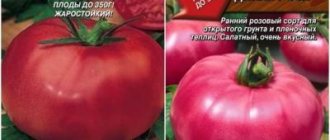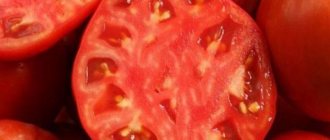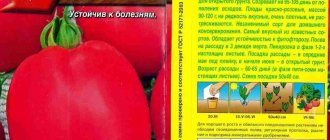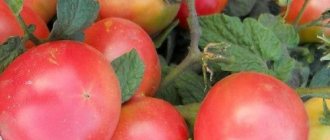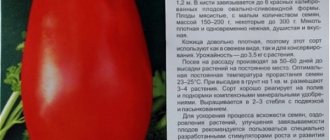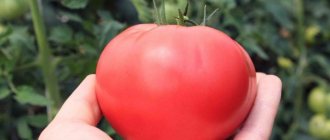An early-ripening, productive, low-growing tomato hybrid from. This is new for 2021. It can be grown both in open ground and in greenhouses. The period from germination to the beginning of ripening averages 75-80 days.
The bush is of a determinate type, compact, 60-70 cm high. Requires tying to a support and pinching up to the first flower cluster. In greenhouses, the manufacturer recommends forming the plant into 2-3 stems.
The leaves of this tomato are of the usual type, the inflorescences are simple with 7-8 fruits. The first inflorescence is laid above 4-5 leaves, subsequent ones through each leaf, or in a row.
Basic qualities of fruits
The fruits are round with lush “shoulders”, large-ribbed at the stalk, dense, red at maturity without a green spot on the shoulders, weighing 120-140 grams, juicy, good tomato taste with sourness. These tomatoes are suitable for early salads, canning, and home cooking.
Advantages of the hybrid: uniform fruiting in any growing conditions, resistance to cracking and blossom end rot. The tomato is tolerant to TMV, Alternaria and late blight.
The productivity of Lyrica tomato in open ground is 9-11 kg/m2 in film greenhouses 13-15 kg/m2.
Tomato Lyrica - variety description
tomato Lyrica
The variety is early ripe and not capricious. It was brought out by the Moscow Region agricultural sector only in 2021. When this hybrid variety was created, the breeders wanted a variety that would produce high yields, tasty fruits and be easy to care for - they succeeded.
The species is grown both indoors and in open beds. Because of this, it is very popular among vegetable growers.
The bush of the variety is small, 1.5 m high. It is not vigorous and compact. Although the bush is small, at the final stages of growth the stems need to be tied up. Because the bushes themselves cannot withstand an overload of tomatoes.
Inflorescences that bear fruit are formed above the 4th leaf from the surface layer of soil. Their further formation occurs through the leaflet. The inflorescence produces several flowers, which later form tomatoes, 8 pieces.
When the Lyrica tomato is grown, the inflorescences can develop on their own. Or you can do them less often to form large and heavy tomatoes.
Description
The appearance of the plant leaves only a positive impression. The bush is determinate, very compact. Regardless of the growing conditions, the maximum height is limited to 70 cm. The shoot formation and foliage of the variety are moderate. The stem and shoots are not very powerful, covered with glandular hairs. The internodes are short, which guarantees frequent formation of inflorescences. The leaves are green, slightly wrinkled, matte, of the usual type. Inflorescences of a simple type. A feature of the variety is the frequent formation of fruit clusters. The first is laid over 4 - 5 sheets. And then brushes appear not only in every leaf node, but also in almost every internode. But it’s worth saying right away that not all plants have this effect, but most of them. The fruit clusters are well filled, 5 - 7 ovaries are formed in them, although there may be more flowers. Basically, all tomatoes are one-dimensional, but larger specimens can ripen in the first cluster. The peduncle is strong, with articulation.
The fruits of the variety are round or flat-round, dense, elastic, thick-walled. A special feature of Lyrica is the wide ribbing of the surface, clearly visible in an unripe tomato. During the ripening process, the folds fill and smooth out, and so-called lush shoulders or cheeks appear near the stalk. The color of an unripe tomato is light green, there is no dark spot on the stalk. The ripe fruit is filled with a rich red color. The skin is thin, but strong, glossy. A pistillate scar is visible at the apex. The pulp is red, very fleshy, tender, juicy, quite dense (somewhat denser than that of the Lyubasha hybrid), aromatic. There are 4 - 6 seed chambers, they are medium or large, well filled, not too many seeds. The originator indicates the taste qualities are very good, the taste is sweet, with a slight sourness. The State Register also notes good taste. Compared to Lyubasha, our heroine still has a little more sourness. But, as always, there is a debate among tomato growers about the taste of early-ripening tomatoes. Of course, the taste qualities of the described hybrid do not match the varietal crops grown in an open garden under the sun, but among early ripening species they definitely stand out for the better. The weight of the tomato, according to the State Register, is 140 grams. The originator claims a weight of 100 to 150 grams.
Productivity
harvest from 1 bush
As already determined above, the harvest is large, so this variety is considered one of the most profitable tomatoes.
The yield of the variety in open ground is about 10 kg per square meter, in protected ground up to 15 kg/m². Considering this feature of the variety, you can feed it to your loved ones and friends, as well as send it for sale.
With the 'Lyrica F1' tomato you won't be left without a harvest
This year, in my garden and on an experimental agricultural field, I tested a lot of new tomato hybrids. These include determinate, semi-determinate and indeterminate varieties. I would like to especially note the hybrid 'Lyric F1' and talk in detail about its unusual characteristics.
Tomato hybrid 'Lyrica F1'
Contrary to the existing opinion that determinate hybrids are not as productive as indeterminate ones, I can say: the yield of the determinate, about 85 cm high, hybrid 'Lyrica F1' reaches 5-6 kg per bush. By growing 4 plants per 1 m² of usable area, you can easily get 20-25 kg of excellent fruits both in open and protected ground.
You may ask, why grow these shorties in greenhouses and hotbeds, why not in open ground? And then, to get the first fruits in a very early period (90-95 days from the opening of the cotyledons) and shorten the growing period by 10-15 days, carrying out only 2-3 fruit harvests. Thus, late blight does not affect tomatoes, which means you do not have to poison the plants, the soil and your health.
Weight of standard fruits 'Lyrica F1' 100-150 g
'Lyrica F1' has round, medium-sized fruits, the weight of standard tomatoes is 100-150 g. The beloved and widely known 'Lyubasha F1' is the closest relative of this hybrid, and it has inherited many positive qualities from it. Beauty is great power: the cute “cheeks” of the stem are charming; the thick red glossy color of “skin and body” is proof of saturation with useful microelements and vitamins; A tiny pistillate scar completes the charm of the appearance.
Beauty is great power
The fruits are elastic, dense, can be transported painlessly at any degree of ripeness and are evenly colored when ripened. Ripe tomatoes retain all the best taste qualities (aroma, sweet and slightly sour taste, pleasant texture) for about 2-3 weeks at temperatures from +2°C to +10°C.
Hybrid 'Lyrica F1' is a rare exception among early varieties and hybrids. It is good for consumption both fresh and for any type of processing: salting, pickling, use for making juices and tomato paste.
'Lyrika F1' is resistant to major tomato diseases and very productive
From reports from our partners - gardeners from different territories and regions of Russia, near and far abroad - we can conclude that the hybrid 'Lyrika F1' is resistant to major tomato diseases. On my personal plot, where the experimental plants were kept until September 20, the bushes, except for minor damage by cladosporiosis, did not suffer from anything, and this fever did not reach the agro plot.
In the next video you will see the hybrid 'Lyrica F1' with your own eyes, and also hear a detailed story about the features of its development and cultivation.
Many thanks to the breeders who gave us such a wonderful hybrid!
Fursov Nikolay Petrovich Ph.D. s-x. sciences, journalist, expert, breeder of fruit and berry crops, chief agronomist
Advantages
The main advantages of the Lyrica variety:
- versatility - tomatoes are suitable for fresh consumption, canning, and preparing salads;
- high yield
- resistance to diseases, fungi, viruses, insects;
- excellent keeping quality - it is possible to harvest two weeks before full ripening, the fruits ripen at home;
- dense skin - resistant to cracking and damage;
- pleasant taste, excellent aroma.
The only drawback is the relatively low weight, but it is compensated by excellent yield.
Characteristics and description of the variety with photos
Tomato Lyrica is a determinate early hybrid that is recommended for planting both in open ground and under greenhouse covers. This early ripening hybrid variety was bred by agricultural breeders near Moscow in 2021.
But tomatoes, despite such a young age for the vegetable market, have already received rave reviews and are widely distributed throughout the middle zone and in the south. Its popularity is also facilitated by the fact that it is equally successfully grown in greenhouses and open beds.
Lyrica externally is a low (55-60 cm) bush, which is characterized by compactness. But despite the short stature and small (120-135 g) weight of tomatoes, the plant, nevertheless, has to be tied up as the fruits ripen, since the branches may not withstand a bountiful harvest.
On the stems of the Lyrica tomato, the formation of fruit inflorescences occurs starting from the fourth leaf above the ground (tassels can form higher, above the 5-6th leaf), then through the leaf. The inflorescence contains several flowers that produce up to 7-8 ovaries. If vegetable growers are interested in obtaining larger fruits, some flowers and even inflorescences can be removed. This will allow the plant to redistribute its forces.
The juicy and homogeneous (without voids) pulp of rounded Lyrica tomatoes has a sweetish taste with a spicy tomato sourness. The fruits themselves have so-called “shoulders” - raised areas around the stalk. Tomatoes are distinguished by medium ribbing, uniformly colored, they have an elegant bright red peel and pulp of the same color. There is no green color at the place where the fruit attaches to the stalk.
Ripening is simultaneous and uniform; 78 days pass from planting seeds to mature tomatoes. Tolerates increases and decreases in air temperature well.
This hybrid variety has good shelf life and is not prone to cracking. It can be stored for several weeks without rotting.
All this, together with the qualities described above, makes this variety universal in use. It is equally good in fresh vegetable salads and slices, and in culinary recipes that involve heat treatment (frying, stewing).
Lyrica tomatoes make excellent canned preparations, but experienced housewives note that to obtain tomato juice it is better to take other tomatoes, since this variety produces very thick juice with a lot of pulp. But this same quality allows you to prepare excellent tomato pastes and ketchups, adjika and canned mixed vegetables and chopped salads from Lyrica.
Characteristics of tomato Lyrica
To better understand the features of a new tomato variety, it is necessary to study its main characteristics. How abundantly does Lyrica bear fruit, and what advantages and disadvantages does the variety have?
Productivity
From the point of view of fruiting and productivity, Lyrica can be considered one of the most profitable tomato varieties. From the moment the seeds are planted to the appearance of the fruit, very little time passes - only 78 days. Bushes of this variety produce a lot of tomatoes - up to 15 kg per bush, up to 20 kg per 1 square meter. m.
Considering the good preservation of the fruits and their high transportability, when growing the Lyrica variety, you can both provide yourself and your friends with tomatoes, and successfully send tomatoes for sale.
Area of application of fruits
Characteristics and description of the Lyric tomato classify the variety as universal. This means that you can use tomatoes completely freely - eat them fresh in salads, add them to snacks, and also can them or heat them. However, it is not recommended to use tomatoes to create juice. Since Lyrica f1 tomatoes are very fleshy, the juice will be appropriate - with pulp.
Resistance to diseases and pests
Among the main advantages of the Lyrica variety, one can note increased resistance to:
- tobacco mosaic virus, which infects the tops;
- late blight - a fungal disease that causes rot and drying out;
- Alternaria blight is another fungal disease that affects leaves, stems and fruits.
The listed diseases especially often harm tomatoes, so it is very valuable that the variety is not susceptible to them.
Tomatoes must be regularly inspected and treated with Bordeaux mixture, copper sulfate solution and home remedies - for example, based on laundry soap or garlic.
Advantages and disadvantages of the variety
Having familiarized yourself with the characteristics and features that Lyric tomatoes have, you can briefly highlight their main advantages and disadvantages.
The advantages of the variety certainly include:
- High immunity to common diseases that affect tomatoes - it’s easy to care for seedlings.
- Unpretentiousness to growing conditions - the variety is suitable not only for greenhouses, but also for open-air beds.
- Early ripening and yield - the full ripening cycle takes only 78 days, the variety bears fruit very abundantly.
- Beautiful, neat and juicy fruits with excellent taste - Lyrica has an unusual but pleasant sourness.
- Versatility - tomatoes can be used in any form, fresh or processed.
- Quite a long shelf life - up to 2 weeks - and good transportability.
The description of Lyric tomatoes is practically free of flaws. The only thing that can be attributed to the disadvantages of the Lyrica tomato is the modest size and light weight of the fruit. However, this feature is compensated by abundant fruiting - small tomatoes in significant quantities completely cover the need for tasty fresh tomatoes.
Advantages and disadvantages of the variety
Having familiarized yourself with the characteristics of this type of tomato, you can safely highlight its disadvantages and its advantages.
First, let's talk about the advantages:
- Caring for seedlings is not difficult.
- This variety is immune to common diseases. This includes tobacco mosaic virus, late blight, and alternaria. These diseases most often affect tomatoes. The fact that Lyrica is not under their control makes the variety even more valuable.
- The plant does not require frequent treatment for pests. This can only be done a few times per season.
- The variety is not capricious regarding growing conditions. He is quite unpretentious. It can be grown in greenhouses and in the garden.
- Brings a big harvest.
- Ripening takes only about 80 days.
- Tomato fruits are not only beautiful and neat, but also very tasty, since the tomato has a sour taste.
- Lyrica tomato fruits are universal, as they can be used both fresh and cooked. The only thing is that this species is not suitable for cooking tomatoes, because it has rather stringy fruits.
- Long shelf life compared to other tomatoes. It is two weeks. But there is one exception: in order to have the same shelf life, tomatoes should be picked unripe.
- Tomatoes of this type have good transportability.
The most interesting thing is that this type has no disadvantages. This further explains why Lyrica is so popular.
Features of cultivation
bush in OG
As we have already learned, planting is carried out both in the open air and in greenhouses. In such cases, seeds are planted first. They do this in warm and fertilized soil, in small boxes.
After the sprouts appear in the boxes, the ground has finally thawed after the winter season, thin out the seedlings and plant them in moist soil. But loosen it first.
Plant tomatoes in soil that has been fertilized before. Tomatoes should be planted in small holes of five sprouts per square meter.
After planting, water thoroughly and treat against pests.
Landing rules
How to plant Lyrica F1 tomatoes? Agronomists do not recommend planting seeds in open soil; be sure to prepare seedlings! Ripening seedlings in a separate container with a nutrient substrate will avoid damage to plants from the negative influence of the external environment. Planting tomatoes in the warm season will not damage the stems from frost and will allow you to reap a good harvest.
A few basic rules for planting Lyric tomatoes:
- Four to five stems are planted per square meter. No more is needed - the plants will not have time to ripen, the root system will be cramped.
- Tomatoes are formed into four stems. If one of the stems has grown too early and has stopped growing, another one can be formed. Thus, up to twenty kilograms of tomatoes are harvested from one square.
- The tomato does not need to be tied up - up to six fruits ripen on a strong cluster, they rarely fall to the ground.
- The Lyric variety can also be grown in open soil without loss of yield. You can harvest only 1 kg less per square meter than with greenhouse planting. But tomatoes ripen faster in a greenhouse.
To protect against sudden temperature changes or when the soil is poor, you can fertilize the soil with special compounds. Whether or not to mulch the soil is the choice of the summer resident. A good productive hybrid will ripen under such conditions. But if you know that frost may strike, then it is better to lay paths between plantings with straw.
Agricultural technology
The described hybrid is not recommended to be planted by direct sowing of seeds into the soil. For early ripening, you need to plant pre-grown tomato seedlings. Seed preparation and seedling cultivation are carried out according to the standard scheme. Seedlings should be ready for transplanting in about 55 - 60 days. Calculate the sowing time taking into account the growing conditions. The recommended planting density is 4 pieces per 1 square meter in a greenhouse, and no more than 5 pieces per 1 square meter. meter on the street. It is recommended to tie the plants to a support, otherwise the heavy ripening clusters may overhang and bend the stem. In a greenhouse, the variety can be formed into 3 - 4 stems, sometimes formation into 5 stems is allowed. In an open garden bed, Lyrica is formed into 2 - 3 stems so that the crop has time to fully ripen on the bush. Although it has been experimentally proven that even 4 stems (but only in warm regions) can produce wonderful results. Stepping is carried out moderately or not at all. Further care for tomatoes is not difficult. Watering in the greenhouse and outside is carried out as the top layer of soil dries. In an open garden, natural precipitation must be taken into account. Fertilizers are applied mainly by universal ones, having a balanced composition. Weeding and loosening the soil after watering are also included in standard agricultural practices.
Lyrica is an excellent variety for an open garden bed or protected ground. The unusual thing about this variety is that in a greenhouse and in an open garden bed it always produces the same high yield. In protected soil, the yield can be higher by a little more than a kilogram, but tomatoes grown under real sun have better taste. Resistance to fungal and viral diseases will allow you to use garden chemicals less often, so the harvest can be environmentally friendly and truly beneficial to health. The fruits are equally good in their natural form and processed. No critical deficiencies were identified during cultivation. The only big disadvantage of the hybrid is the still high price of seed material and the need to constantly purchase seeds.
Reviews of tomato "Lyrica"
Still in doubt? Several reviews from the first buyers of the variety are below.
Valery, 56 years old, Astrakhan: “I am grateful to “Partner” for a really good hybrid! It’s been a long time since I’ve had time to tie up bushes on my plot, mulch the ground, and harvest crops every day. If you also come to the dacha from time to time, plant Lyrica, don’t even think about it. I only planted a few squares in the greenhouse, and I already regret it. I collected 35 kilograms, all the fruits are fragrant and tasty. They lasted a week for sure, but we picked them very ripe.”
Alena, 37 years old, Ryazan: “I have long wanted to plant an early-ripening tomato on my plot, but I couldn’t find one that suited my taste. I don’t have a greenhouse, so the choice narrowed even more. Last year I planted Lyrica for the first time and was very pleased. The taste is like summer varietal tomatoes, the smell is simply excellent, the tomato itself is not watery, but rich. It is easy to care for; in open soil, all the seedlings grew well even without fertilizer. We collected about forty kilograms, rolled them up a little, but liked them better in salads.”
Maxim, 43 years old, Moscow region. “I was looking for a good and, most importantly, productive tomato with an early ripening period (I prefer mid-ripening ones, after all). “Lyrica” did not disappoint - the yield is about 17 kilograms per square, the tomatoes do not fall to the ground, do not get sick, and do not taste like “water.” The only mistake was that we wanted to make juice, but there were too many seeds and it didn’t work out. For salads, just eating is the best.”
Reviews from gardeners who planted the Lyrica variety
Sergeev Vladislav Anatolyevich, living in the city of Penza, shared his review:
“I recently tried to plant the Lyrica tomato variety for the first time. I planted it on my summer cottage, and now I can call it one of my favorite tomatoes. I was shocked by its rapid development. The fruits it produces are not large, but they are very juicy and tasty. And by the way, they are beautiful. They can be stored for quite a long time and can be used however you like.”
Astakhova Anna Petrovna, Ryazan:
“I once heard positive reviews about this variety. I decided to plant it in my greenhouse. I was absolutely delighted. The tomatoes ripened in just three months. She reaped a truly excellent harvest. One bush yielded 19 kilograms of tomatoes. I also liked the taste. He's quite unusual. Sweetish, but at the same time has some sourness.”
Rimma, from the city of Daugavpils, shares:
“I really liked the Lyrica tomato variety, I will plant it next year. The harvest is, of course, excellent, and so is the taste.”
Natalya, Rostov-on-Don:
“I saw a photo of the Lyrica tomato variety, I really liked its characteristics, after that I decided to try planting tomato seeds in the soil and not in a greenhouse. The tomatoes completely met all my expectations. Despite the fact that the spring was quite cool, the tomatoes ripened in 78 days, fulfilling their promise. From each bush I collected about fifteen kilograms of tomatoes. This is very good for the garden.”
Alena, from the city of Ryazan shared:
“Quite a long time ago I wanted to plant an early-ripening tomato on my plot, but I couldn’t find one that was suitable in terms of taste. The choice was quite narrow, since I do not have a greenhouse. And finally, last year, I was able to plant the Lyrica tomato variety for the first time. I was very pleased. The taste is like summer tomatoes, the smell is pleasant, the tomato itself is not watery, but rich. It is generally very easy to care for. In open-air soil, seedlings began to grow even without fertilizers. We collected about 40 kilograms. I rolled some and used some in salads. So I liked the taste in salads the most.”
How to plant Lyrica tomato and its agricultural technology
The variety is grown in open and closed ground. In these two cases, the seeds are first planted in insulated and saturated soil, in small containers. Sowing is carried out in the last days of March. The seedlings will have time to sprout in the spring, when there are no repeated frosts and the earth warms up.
After the emergence of seedlings and the final thawing of the soil, the seedlings are thinned out and then planted in moist, loose soil. Seedlings must be planted in saturated soil. In small holes, we plant 5 bushes per square.
After the plants are planted, abundant watering is carried out, and the shoots are simultaneously treated against harmful insects in order to protect them at the first stage of development.
Agrotechnical principles
Seedlings should be watered when necessary: when the soil dries out. Tomatoes like moist soil, which means we water them 2 times/7 days, 2 times a day. When the fruits ripen, the bushes need more moisture, so we closely monitor this.
During cultivation, shoots are inspected and, if necessary, excess shoots are pruned. One bush should have 2-4 stems. Otherwise, the roots will interfere with each other, development will slow down, and the harvest will be small.
Plants require weeding and removal of weeds that steal nutrients from the fruit and infect them with diseases.
It is also necessary to pruning the stems. All excess shoots that do not bear fruit are removed. Stepchildren, if not controlled, can grow, and the yield will decrease because of this, because the main stem will not receive enough water and nutrients.
Grown plants require support. One bush can produce 20 kg of fruit, but the stems may not carry this and may break.
If the soil for growing tomatoes is infertile, then potassium and nitrogen can be added to the seedlings. You can mulch the soil in case of repeated frosts, just to be on the safe side. Mulch will be a good protector of seedlings from freezing and will retain water and nutrients.
In greenhouse conditions, the ripening of the variety occurs faster and more actively than in open ground.
But even in open beds, the variety produces excellent fruit; the yield is only a couple of kg less. Here you decide where to plant this variety.
Characteristics of the variety
- Lyrica is an early ripening variety. But growing conditions can affect this feature - shorten or slightly increase the ripening period. In closed ground, you can start collecting ripe tomatoes 80 days after the first cotyledon leaves appear on the seedlings. In an outdoor garden bed this will happen in 90 - 95 days;
- Despite its short stature, the plant is distinguished by its high yield, which can be the envy of some tall crops. The State Register provides data on 15.3 - 16.5 kg collected from 1 square meter under film covers. The originator claims 20 and even 25 kg from the same area, and, as noted, this result is possible both indoors and outdoors. Thus, it can be calculated that 1 bush brings 5 - 6 kg. Tomato growers claim 4 - 4.5 kg per plant;
- by growing the variety in greenhouse conditions, the vegetable grower can count on a friendly harvest, as a result of which Lyrica can be used for repeated circulation;
- ripened tomatoes do not fall off the brushes;
- the skin perfectly protects ripe tomatoes from cracking even at high humidity;
- The immunity of the variety is excellent throughout the growing season. The species is resistant to blossom end rot and tolerant to tobacco mosaic virus and Alternaria blight. Thanks to the early and friendly ripening of the crop, Lyrica manages to avoid fusarium;
- if the variety is grown in unprotected soil in cool regions, then the harvest can be harvested at the stage of blanzhe ripeness. The fruits ripen perfectly in room conditions within a few days;
- The plant's adaptability to adverse weather conditions is good. And the low growth will make it possible, in the event of a sharp drop in temperature, to easily hide tomato bushes under a film cover;
- transportability is excellent - elastic tomatoes will not wrinkle and will not lose their excellent commercial qualities, which is very important when growing products for sale;
- keeping quality does not disappoint either. At temperatures from +2°C to +10°C, the crop will last for 2 - 3 weeks without loss of appearance and taste;
- the method of consumption, like most early-ripening varieties, is salad. But the dense consistency, suitable size and strong skin allow the excess Lyrica harvest to be used in whole-fruit canning. The fruits can also be salted, pickled, processed into paste, and used in cooking.
Plant care
formed bushes in a greenhouse
There are some other rules of care that require you to strictly follow:
- Watering should be done as needed or when the soil begins to dry out. Tomatoes love moisture very much, so watering should be done no more often and no less than twice a week, twice a day. It is especially important to monitor humidity during ripening, because during this period the plant needs water most. This is necessary for the tomato to fully ripen.
- As your tomato bush grows, you should inspect it and trim off unnecessary things. It is best to leave no more than four stems on the bush so that the development of tomatoes does not slow down. And if you do not listen to this advice, then there is a high probability that the yield will be unsatisfactory.
- Seedlings should be weeded as often as possible to avoid the appearance of weeds that will negatively affect the development of the plant.
- Another very important procedure for a tomato plant is pinching. All tomato shoots that do not participate in the development of the fruit must be removed. Otherwise, the “stepchildren” will begin to grow without control, and then the main plant will be deprived of moisture and nutrients.
- The grown shoots should be strengthened and tied to a support.
- If you think that the soil is not nutritious, then it should be fed with potassium or nitrogen fertilizers.
Features of planting and caring for Lyrica f1 tomatoes
Tomatoes of this variety can be planted both in a greenhouse and in an open bed. In both cases, the seeds are first planted - in warm and fertilized soil, in small boxes. This should be done around the end of March. Then the seedlings will have time to sprout just in time for full spring warming, when the soil warms up.
After sprouts appear in the boxes and the ground has completely thawed, the seedlings will need to be thinned out and then planted in moist, loose soil. Plant tomatoes in fertilized soil in small holes - 5 sprouts per 1 square meter. m. Immediately after planting, the tomatoes are watered abundantly; it is recommended to immediately treat them against pests in order to protect young shoots at an early stage of development.
The rules for caring for the Lyrica tomato are quite simple and do not require much effort from gardeners. It is enough to follow several procedures.
- Watering the seedlings is carried out as needed - as the soil dries out. Tomatoes love moist soil, so it is recommended to add moisture at least twice a week, 2 times a day. Particular attention should be paid to hydration during the period of fruit ripening - at this time the plant requires an increased amount of water.
- As the tomato bush grows, the shoots are inspected and, if necessary, the excess shoots are cut off. It is better to leave no more than 2-4 stems in one bush - otherwise the roots will simply interfere with each other, the development of the plant will slow down, which will affect the yield.
- Seedlings in open ground and in greenhouses are regularly weeded to remove weeds, which not only take away nutrients from tomatoes, but also contribute to the development of diseases.
- Another necessary procedure is pinching the stems. The bottom line is that all excess shoots that are not involved in fruiting are removed from the plant. “Stepchildren” without control can grow greatly, and then this will affect the yield, since the main plant will receive less moisture and nutrients.
- The grown shoots are strengthened and tied to a support. One Lyrica tomato bush can produce up to 20 kg of tomatoes - sometimes the stems cannot withstand the load and simply break.
If the soil in which tomatoes grow is not nutritious enough, the seedlings can be fed with potassium or nitrogen fertilizers. Sometimes it is advisable to use mulching - for example, if spring frosts are still expected, and tomatoes are growing in the open air. A dense layer of mulch will protect the seedlings from freezing and help retain moisture and nutrients.
Important! In the greenhouse, Lyrica tomatoes always ripen faster and more abundantly than in the garden.
However, even in the open air the variety bears fruit very well - the yield can be only 1 - 2 kg less. Therefore, the choice of landing site depends only on personal preferences and capabilities.
